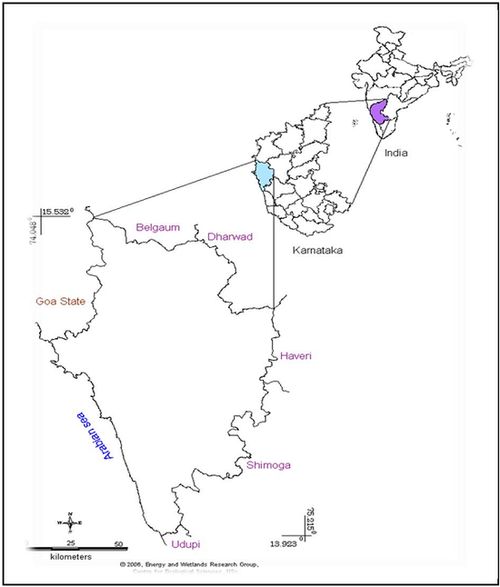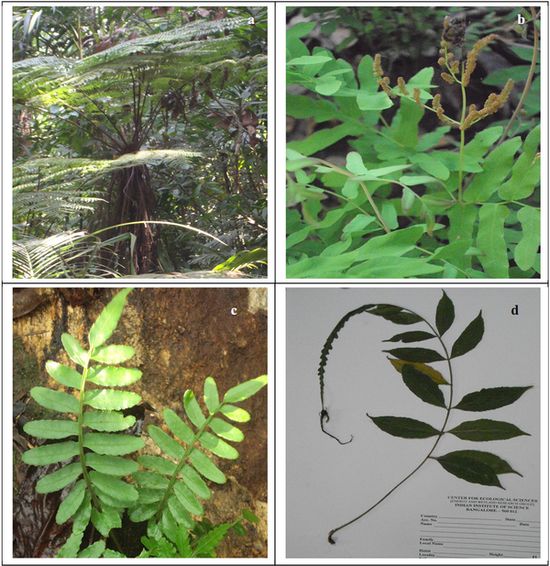PTERIDOPHYTE DIVERSITY IN UTTARA KANNADA DISTRICT Uttara Kannada is the northernmost coastal district of Karnataka covering an area of 10,291 km2. It extends from north south to a maximum of 180 km, and from west to east a maximum width of 110 km. The Arabian Sea borders it on the west creating a long continuous, though narrow, coastline of 120 km running north‑south. Towards its north are Goa and Belgaum, to the east are Dharwad and Haveri and to the south are situated Shimoga and Udupi.The district comprises of 11 taluks namely, Joida, Haliyal, Mundgod, Yellapur, Karwar, Ankola, Sirsi, Siddapur, Honavar, Kumta and Bhatkal. Topographically, the district can be divided into 3 distinct zones namely narrow and flat coastal zone, abruptly rising ridge zone and elevated flatter eastern zone. The coastal zone is thickly populated with coconut clad villages. Ridge zone is a part of the main range of Western Ghats, which runs north to south, parallel to the coast. The flat eastern zone joins the Deccan plateau. The taluks, which comprises the narrow flat coastal zone, are: Karwar, Ankola, Kumta, Honnavar and Bhatkal. A significant portion of central Western Ghats is spread in the district and more than 70% of the district is covered by forest area. These forests harbor excellent diversity of flora and fauna with the presence of some highly endemic and endangered species. Figure 3: Study area – Uttara Kannada district, Karnataka state, India The earliest record referring to ferns in this region was by Matchperson (1890) who collected and listed 75 species of ferns from North Kanara district. Later, Blatter and Almeida (1992) included 90 species of ferns from Uttara Kannada district, then a part of Bombay Presidency, in their “Ferns of Bombay”. The most comprehensive study of ferns and fern allies of central Western Ghats of Karnataka were carried out by Rajagopal and Bhat (1998); this work includes 64 species of pteridophytes collected from Uttara Kannada district. Our study in the district added three more species taking the total to 67 species. These species include both ferns and fern-allies belonging to 28 different families.The details of the plants such as botanical names, families, habitat and ecology along with their distribution in the district (talukwise) are explained in Table.1. The major families represented in the district are Selaginellaceae, Pteridaceae, Thelypteridaceae, Woodsiaceae and Polypodiaceae. The species which are distributed widely and grow luxuriantly in the district include Lycopodiella cernua, Lygodium flexuosum, Pteris quadriaurita, Pityrogramma calomelanos, Adiantum philippense, Pteridium revolutum, Dicranopteris linearis, Thelypteris (Christella) dentata, Tectaria coadunata, Bolbitis subcrenatoides, Blechnum orientale and Drynaria quercifolia. Four fern species namely Cyathea nilgirensis, Osmunda huegeliana, Bolbitis semicordata and Bolbitis subcrenatoides are endemic to South India (Fraser-Jenkins, 2008b) and are also present in the district. Of these, Bolbitis semicordata is a rare species in South India whereas Cyathea nilgirensis is Near-threatened implying a high conservation status to them (Chandra et al, 2008). 67 species of ferns and fern-allies are found to be distributed across various taluks of Uttara Kannada district. Majority of the species are found to be concentrated in the Joida (41 species), Karwar (25 species), Siddapur (30 species), Yellapur (12 species), Sirsi (10 species) and Kumta (15 species) taluks of the district. The forests in Castle rock (Joida taluk) and Kaiga (Karwar taluk) together were found to be harboring maximum species of ferns and fern-allies in Uttara Kannada district. The Gerusoppa Ghat, spread in the Siddapur and Honnavar forest divisions, with primeval evergreen forests was also found to be a rich spot beaming with luxuriant growth of pteridophytes. The endemic and threatened tree fern species – Cyathea nilgirensis was located to be present in Kathalekan sacred forests in Gerusoppa Ghat. Our studies are ongoing and within another year we will be in a position to report more number of localities of occurrences for most ferns reported from the district. Figure 4: Endemic pteridophytes of Uttara Kannada district – (a) Cyathea nilgirensis; (b)
Osmunda huegeliana; (c) Bolbitis semicordata; (d) Bolbitis subcrenatoides The most common and widespread fern species which were found to be present in maximum taluks of the district are Dicranopteris linearis and Blechnum orientale. These ferns can be found growing along road cuttings in partial shade or open places. The most common and widespread epiphytic ferns is Drynaria quercifolia which grows on the bark of different trees in moist deciduous and semi evergreen forests and even on old roadside trees. Pteridium revolutum is an alien invasive fern which was initially cultivated in various parts of Western Ghats, but has now escaped into the wild and grows prolifically as terrestrials on fully exposed grassy slopes on the forest edge, roadsides and clearings. Another noteworthy fern species in the district is Acrostichum aureum which grows gregariously in the tidal backwaters in the costal taluks of the district. This is the only species of fern known so far to grow in the brackish water environs of the region. The two aquatic ferns namely Marsilea minuta and Azolla pinnata are found growing in ponds, paddy fields and other such marshy places in the plains of the district. |

